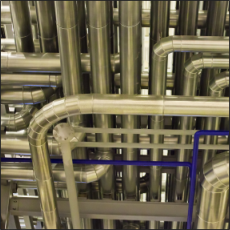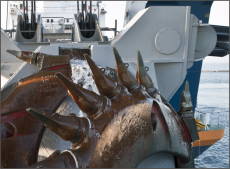Aggregate Projects
Kruse Integration has experience providing automation solutions in a variety of industries. Our staff of seasoned engineers can provide solutions in industries as diverse as pharmaceuticals, chemical processing, steel making and food and beverage. We have automated many different process types, including discrete manufacturing , continuous and batch processes. We have developed ways to improve efficiency, reduce downtime and increase production in many facilities.
We complete over 200 projects annually. Kruse Integration specialists can provide answers for your specific needs.
Palm Beach Aggregates Location – West Palm Beach, Florida
Customer: Palm Beach Aggregates
Location: West Palm Beach, Florida
Description: The customer had an existing dragline crane operation on site approximately 4 miles away from the aggregate plant. They installed a 4 mile belt conveyance and screening system to replace the truck transfer of material from the dragline to the plant.
Details: The system consists of 14 belt conveyors, one of which is a ½ mile long floating conveyor. Additionally as the material is transferred to the plant, it goes through a new screening process where the material is divided into base rock (which is distributed to stock piles by a track mounted mobile “Bird Stacker”) and plant feed. The plant feed can divert to a radial stacker or to the existing plant process. The control portion of the automation system includes a main PLC processor and eight remote I/O rack Ethernet I/P locations communicating with each other via a fiber-optic network and 5.8 GHz wireless radios. Ethernet I/O was utilized to enable remote login for data collection and diagnostics through the 2 graphical HMI computers and use of Terminal Services or RDP.
The Operator sits in the dragline feed crusher where he can control the entire conveyance system. The graphics depict the actual system while displaying status, alarms, motor currents, trends and startup/shutdown sequence controls. All safety interlocks as well as hardwired shutdowns were considered and implemented in the PLC code and field logic.
Oldcastle – Shelly Division Primary Plant Automation
Aggregate Primary Plant Automation
Customer: Oldcastle – Shelly Division
Location: Columbus, OH
Description: When the customer decided to expand their unautomated 1200 TPH primary plant to include a secondary recrush loop and additional product screening, they hired Kruse Integration to design and implement a state of the art automation system.
Details: The control portion of the automation system consisted of a main PLC processor and two remote I/O locations communicating with each other via a fiber-optic network. Remote I/O was utilized to reduce field installation costs and fiber-optic networking was used for electrical noise immunity. A main HMI workstation replaced a hardwired pushbutton panel in the primary operator’s control room. From the HMI, the operator could monitor and control the entire plant, including primary and secondary crushers, all feeders, conveyors, screens and stackers. In order to eliminate the paperwork load on the operator, four product scales and one main scale where interfaced to the PLC system for production data collection. Automatic downtime data was collected by triggering a downtime event whenever the primary feeder stopped or crusher production dropped below a threshold. Production and downtime data was stored in a database server located in the plant office. Networking to the database was accomplished via a wireless Ethernet network. Reports for production and downtime were created to be viewed with a standard web browser. Anyone with an Internet connection and authorized network access could view the reports. Post-startup support was enhanced by configuring remote access for the system. Via a router mapping of a “real-world” I.P. address and Microsoft’s Remote Desktop Connection client, Kruse Integration can access all computers and PLCs for maintenance and troubleshooting from any Internet access point.
Points of Interest: Automatic primary feeder control based on conveyor and crusher motor amperages maximizes production and relieves operator of continuous feeder adjustments • Constant monitoring by automation system provides safer and more reliable operation • Graphical operator interface helps new operators run the plant with minimal training • Automatic production and downtime data collection provides more accurate data than the old manual worksheet logging system performed by the operator • Web-based reporting provides management flexible and constant access to production and downtime information
Beverly Materials Secondary/Wet Plant Automation Retrofit
Aggregate Secondary/Wet Plant Automation Retrofit
Customer: Beverly Materials
Location: Elgin, IL
Description: The customer’s existing automation system was PC based and antiquated. After they reached the point where it was unusable, they hired Kruse Integration to retrofit the plant with a new and improved automation system.
Details: The old computer control system interfaced to three separate motor control centers (MCCs) via a DeviceNet network. Since considerable capital had been spent on the DeviceNet MCCs and they were in good working condition, we recommended that they be reused. The old computer system was removed and replaced with a PLC system equipped with DeviceNet scanners. The existing DeviceNet starters were reconfigured to allow the new PLC control program to control all plant devices. Dual HMI workstations replaced the old computer workstation. From the HMI, the operator could monitor and control the entire plant, including secondary and tertiary crushers, all feeders, conveyors, screens and stackers. As a system enhancement, the main belt scale was interfaced to the PLC system for production data collection. Automatic downtime data was collected by triggering a downtime event whenever the tunnel feed belt stopped. Production and downtime data was stored in a database server located in the plant office. Networking to the database was accomplished via a wireless Ethernet network. Reports for production and downtime were created to be viewed with a standard web browser. Anyone with an Internet connection and authorized network access could view the reports. Post-startup support was enhanced by configuring remote access for the system. Via a router mapping of a “real-world” I.P. address and Microsoft’s Remote Desktop Connection client, Kruse Integration can access all computers and PLCs for maintenance and troubleshooting from any Internet access point.
Points of Interest: With a life expectancy of over 15 years, the PLC system provides a more reliable long term automation solution then the PC based system • Operator confidence in the new system resulted in an increase in production totals for minimal cost • Reusing the existing MCCs reduced the project cost considerably and resulted in a return on investment of several months












